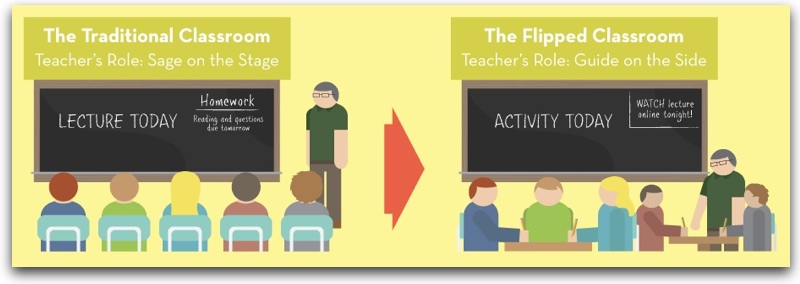Developing Your Flipped Approach

Even before Salman Khan began recording videos in 2004 to support his cousin’s learning, which soon lead to the birth of the now-famous Khan Academy, the idea of ‘flipping the classroom’ was not new. Where students generally got information in class and then applied that information later on their own, by way of homework or projects for example, educators and researchers starting thinking in the mid-1990s that switching up that approach could have a positive impact on student learning.
In a nutshell, as you likely already know, flipping the classroom means to give the students the knowledge they need before they come to class, so class time can then be spent on the practical application of that knowledge. Proponents of this strategy highlight its many benefits, such as giving students more control over the pace at which they learn, providing more access to information and freeing up teacher time during class so he or she has more time to work with students and ensure they really understand.

There are issues, however, including a sometimes-unequal access to technology and the amount of front-end work it could take to prepare materials. One of the biggest points often made in the argument against flipping the classroom, however, is that it is heavily dependent on the students actually doing the work before they come to class. If they do it, great; if they don’t, they come to class unprepared and the plan to spend the class with practical, student-centred learning activities goes out the window. This is a particular problem with students are not used a flipped approach, and even more so if your learners are not motivated and independent.
The more you practice the flipped approach, the more your learners will become used to it. Getting them motivated and training them to do this work on their own is a bit more challenging. Fortunately, there are some considerations you can make when preparing your flipped material that will encourage your students to complete their work and, hopefully, retain more information for that practical application later in class.
Make it Engaging
 While videos are most commonly associated with the flipped classroom approach, a video alone is never enough. Asking students to watch a video with no supporting activity lacks any engagement factor, which in turn will affect student motivation. Other than the very keen and most independent learners, many students will watch a video once and retain almost none of the information needed to be active participants in class the next day. At best, most will be passive receivers of information; at worst, they won’t watch the video at all. When students are provided a task in connection with the video, they will be required to interact with the knowledge; this immediately makes the task more engaging, which in turn will motivate the learners and increase retention.
While videos are most commonly associated with the flipped classroom approach, a video alone is never enough. Asking students to watch a video with no supporting activity lacks any engagement factor, which in turn will affect student motivation. Other than the very keen and most independent learners, many students will watch a video once and retain almost none of the information needed to be active participants in class the next day. At best, most will be passive receivers of information; at worst, they won’t watch the video at all. When students are provided a task in connection with the video, they will be required to interact with the knowledge; this immediately makes the task more engaging, which in turn will motivate the learners and increase retention.
Make it Trackable
 Another strategy that is important for the success of the flipped classroom, which also serves to make materials more engaging and motivating, is to make materials that are trackable. Just as giving your students a video to watch isn’t going to motivate them or help them learn, neither will giving them material that you don’t know whether or not they’ve completed, regardless of how engaging the material is. Providing material you can track has many benefits: if your students know you know if they’re doing their work a lot, they are more likely to do it; if you’re able to record your students’ completion and performance, you can use it as part of a participation grade; if your students don’t do the work you have evidence to show students why, perhaps, they aren’t doing so well; and, you can use the results as an ongoing formative assessment, to help you keep your eye on student learning.
Another strategy that is important for the success of the flipped classroom, which also serves to make materials more engaging and motivating, is to make materials that are trackable. Just as giving your students a video to watch isn’t going to motivate them or help them learn, neither will giving them material that you don’t know whether or not they’ve completed, regardless of how engaging the material is. Providing material you can track has many benefits: if your students know you know if they’re doing their work a lot, they are more likely to do it; if you’re able to record your students’ completion and performance, you can use it as part of a participation grade; if your students don’t do the work you have evidence to show students why, perhaps, they aren’t doing so well; and, you can use the results as an ongoing formative assessment, to help you keep your eye on student learning.
Make it Real
 Creating engaging, trackable flipped classroom material is the most important way to ensure the developing success of the strategy, but there is still another important consideration. The students need to know that this is your strategy and that they must take on some independence if they are going to succeed during class time and throughout a course. That means making a plan and sticking to it; if you tell students they need to do this work outside of the classroom make sure they know you mean business. Follow through by making the next class one where they need the knowledge to participate actively and successfully. Those who have done the flipped work will be prepared; those who have not done it will not, and will understand the importance of doing so next time.
Creating engaging, trackable flipped classroom material is the most important way to ensure the developing success of the strategy, but there is still another important consideration. The students need to know that this is your strategy and that they must take on some independence if they are going to succeed during class time and throughout a course. That means making a plan and sticking to it; if you tell students they need to do this work outside of the classroom make sure they know you mean business. Follow through by making the next class one where they need the knowledge to participate actively and successfully. Those who have done the flipped work will be prepared; those who have not done it will not, and will understand the importance of doing so next time.
Make it Open
 That said, there does need to be a transition period for students who are new to the idea or processes involved with succeeding in a flipped classroom. It is best to follow through and make your flipped classroom a reality for learners, but it may take them a while to get the hang of it. During this transition time, it will be important to make some modifications to the plan or provide some class time for preparation for those students who didn’t quite understand the importance of doing their work ahead of time. You don’t want to do this at too much cost to those students who did get it, and you don’t want to do it forever, but you will want to consider it until your students fully understand what is needed. It is also important – in the beginning and always – to provide ways for your leaners to ask questions and seek support from you and even from their peers. A discussion board or an open collaborative resource such as a Padlet wall, for example, could go a long way toward supporting your learners.
That said, there does need to be a transition period for students who are new to the idea or processes involved with succeeding in a flipped classroom. It is best to follow through and make your flipped classroom a reality for learners, but it may take them a while to get the hang of it. During this transition time, it will be important to make some modifications to the plan or provide some class time for preparation for those students who didn’t quite understand the importance of doing their work ahead of time. You don’t want to do this at too much cost to those students who did get it, and you don’t want to do it forever, but you will want to consider it until your students fully understand what is needed. It is also important – in the beginning and always – to provide ways for your leaners to ask questions and seek support from you and even from their peers. A discussion board or an open collaborative resource such as a Padlet wall, for example, could go a long way toward supporting your learners.
Developing students to become successful flipped classroom participants can take some time and there will be challenges along the way. However, a game plan that includes these approaches will help both you and your learners develop strategies that contribute to success in the long run.
Subscribe to our Newsletter
Recent Posts
Teaching infographics #2 – VOCAL: Traits of a Successful Online Teacher
This graphic is a quick guide for some common s...10 routines for teaching online – #4 Talk types
The idea of ‘talk types’ is loosely...
Differentiating Instruction in Your LMS
Anyone who has been in the world of education f...
Authors
- Andy Steele (9)
- Azim Ahmed (12)
- Christine Lampe (3)
- Gemma Escott (1)
- Larry Davies (25)
- Mahinour Ezzat (1)
- Raghad Nihlawi (16)
- Samantha McDonald Amara (16)
- Sarah Whittaker (55)
- Silishi Noushad (1)
Categories
- Adult Learning
- Assessment
- Blackboard
- Blackboard
- BookWidgets
- Collaborate Ultra
- Ed Tech
- Grade Center
- ILC
- Infographics
- Instruction
- Learning Technology Tools
- Microsoft
- Mobile OS
- Mobile Technology
- Nearpod
- News & Events
- PLAs
- Professional Development
- Routines
- Teaching with Technology
- Uncategorized
- Webinars
Tag Cloud
Archives
- February 2021
- November 2020
- October 2020
- September 2020
- August 2020
- July 2020
- June 2020
- May 2020
- April 2020
- March 2020
- February 2020
- January 2020
- December 2019
- November 2019
- October 2019
- September 2019
- August 2019
- June 2019
- May 2019
- April 2019
- March 2019
- February 2019
- March 2016
- January 2016
- November 2015
- October 2015
- June 2015
- May 2015
- March 2015
- February 2015
- January 2015
- November 2014
- October 2014
- September 2014
- August 2014
- June 2014
- May 2014
- April 2014
- March 2014
- February 2014
- January 2014
- September 2013
- January 2013
- December 2012
- November 2012
- October 2012
- July 2012
- April 2012
- March 2012
